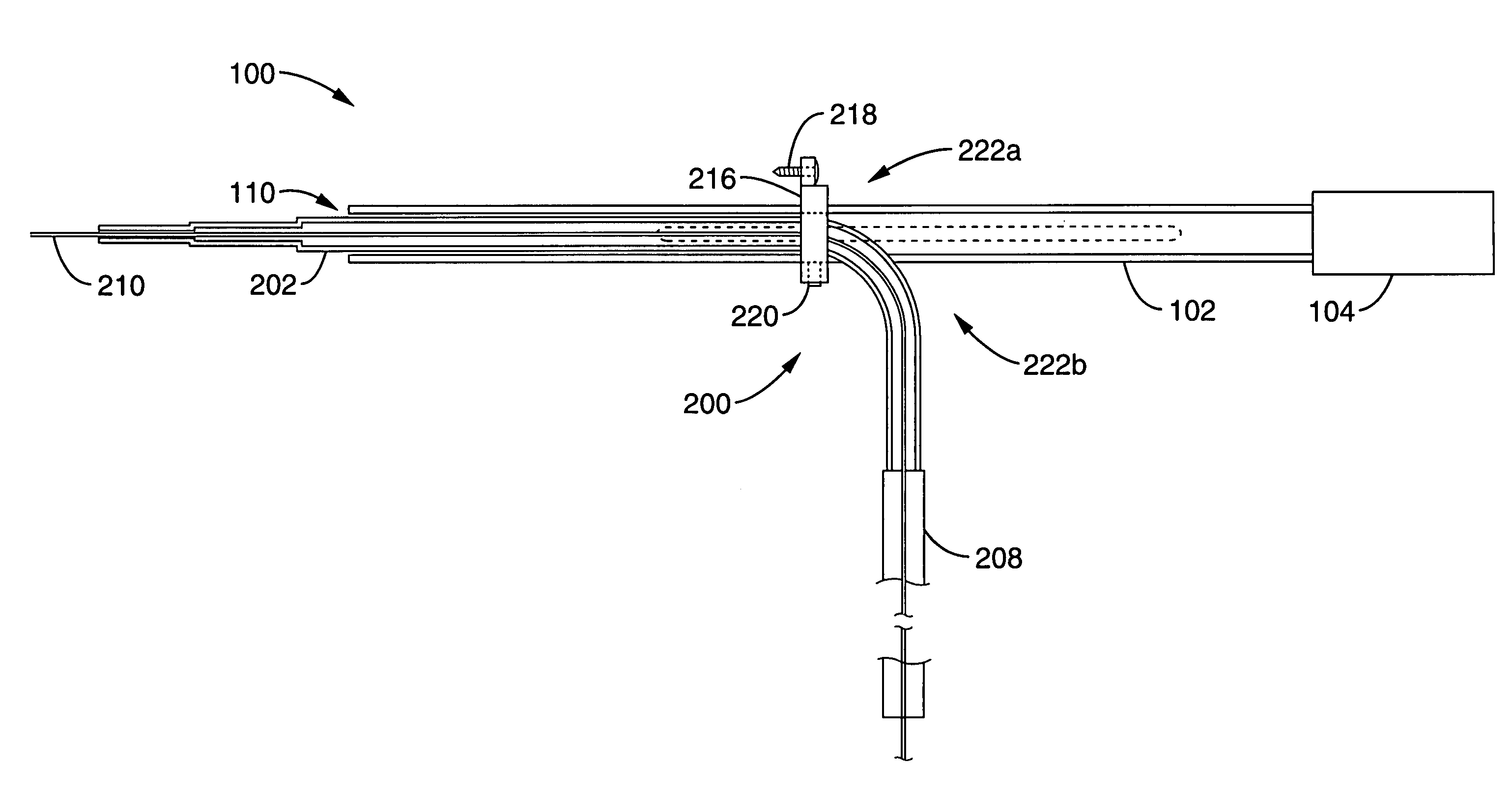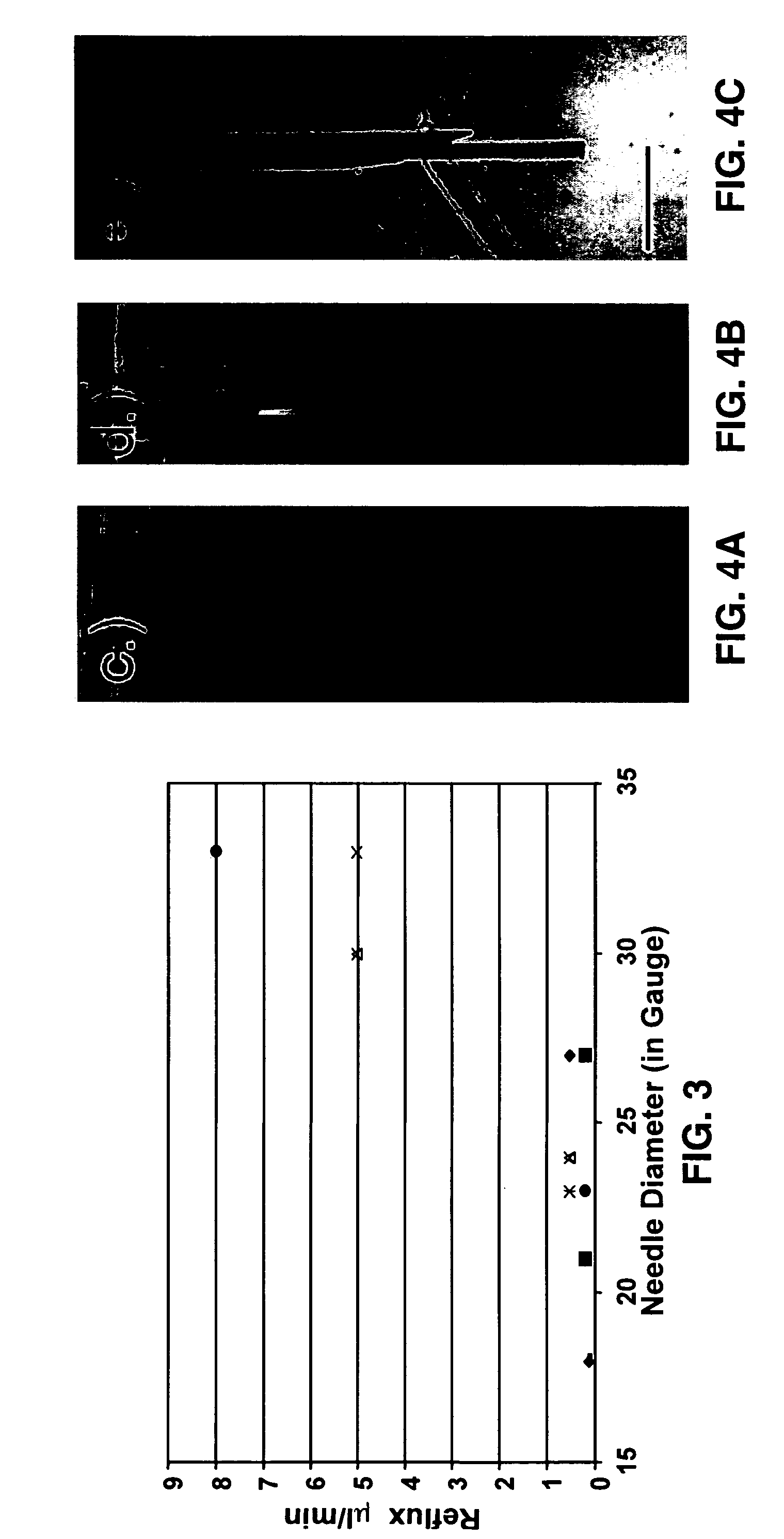Reflux resistant cannula and system for chronic delivery of therapeutic agents using convection-enhanced delivery
a technology of convection-enhanced delivery and reflux resistance, which is applied in the direction of catheters, guide needles, other medical devices, etc., can solve the problems of non-uniform outer diameter (od) of tubes, and achieve the effect of increasing flow ra
- Summary
- Abstract
- Description
- Claims
- Application Information
AI Technical Summary
Benefits of technology
Problems solved by technology
Method used
Image
Examples
example 1
Agents Infused
[0086]0.4% trypan blue solution was purchased from (Sigma, St. Louis, Mo.). All liposomes were prepared by lipid-film hydration using HEPES-buffered saline (pH 6.5) as the hydration buffer. Each sample was hydrated by 6 successive cycles of freezing (−80° C.) and thawing (60° C.). Unilamellar liposomes were formed by extrusion using a 10 ml-capacity thermostatted extruder (Northern Lipids, Vancouver, Canada). Extrusion was performed through polycarbonate membranes using the appropriate pore size and number of extrusions required to reach the desired liposome size (approximately 80 nm), which was determined by light scattering (Beckman Coulter, Fullerton, Calif.). Cholesterol was obtained from Calbiochem (San Diego, Calif.). 1,2-dioleoyl-sn-glycero-3-phosphocholine (DOPC) and 1,2-distearoyl-sn-glycero-3-phosphoethanolamine-N-[methoxy(polyethylene glycol)-2000] (PEG-DSPE) were all purchased from Avanti Polar Lipids (Alabaster, Ala.). All liposomes were composed of a 3:2 ...
example 2
The Gel Model
[0087]We used 0.5% agarose gel (Life Technologies, Gaithersburg, Md.) mixed with PBS for all experiments. All cannulas were fixed with a holder attached to a stereotaxic frame to minimize irregularity (5). The tip of the step-design cannula was placed at the depth of 20-25 mm in the gel and CED with trypan blue was started. Each flow rate for each conventional cannula and each step-design cannula of the present invention was tested at least 4 times to assess reflux. All pictures were taken with a digital camera at the end of the projected delivery time at each flow rate (Canon SD-100, Canon, Lake Success, N.Y.).
example 3
Rodent Study
[0088]Male Sprague Dawley rats weighing 250-300 g (Charles River Laboratories, Wilmington, Mass.) were used. The protocol used in these studies was approved by the Institutional Animal Care and Use Committee of the University of California, San Francisco. While under deep isoflurane (Aerrane, Omeda PPD, Liberty, N.J.) anesthesia, rats were placed in a small animal stereotaxic frame (David Kopf Instruments, Tujunga, Calif.). A sagittal incision was made through the skin to expose the cranium, and a burr hole was made in the skull at 0.5 mm anteriorly and 3 mm laterally from the bregma with a small dental drill. Infusions were performed at the depth of 5 mm from brain surface by using the CED method described previously (2, 14, 17). The infusion system consisted of three components: (i) a step-design cannula; (ii) a infusion line containing the infused agent and (iii) a infusion line containing olive oil. The three components were connected using flangeless fittings (Upchu...
PUM
 Login to View More
Login to View More Abstract
Description
Claims
Application Information
 Login to View More
Login to View More - R&D
- Intellectual Property
- Life Sciences
- Materials
- Tech Scout
- Unparalleled Data Quality
- Higher Quality Content
- 60% Fewer Hallucinations
Browse by: Latest US Patents, China's latest patents, Technical Efficacy Thesaurus, Application Domain, Technology Topic, Popular Technical Reports.
© 2025 PatSnap. All rights reserved.Legal|Privacy policy|Modern Slavery Act Transparency Statement|Sitemap|About US| Contact US: help@patsnap.com



